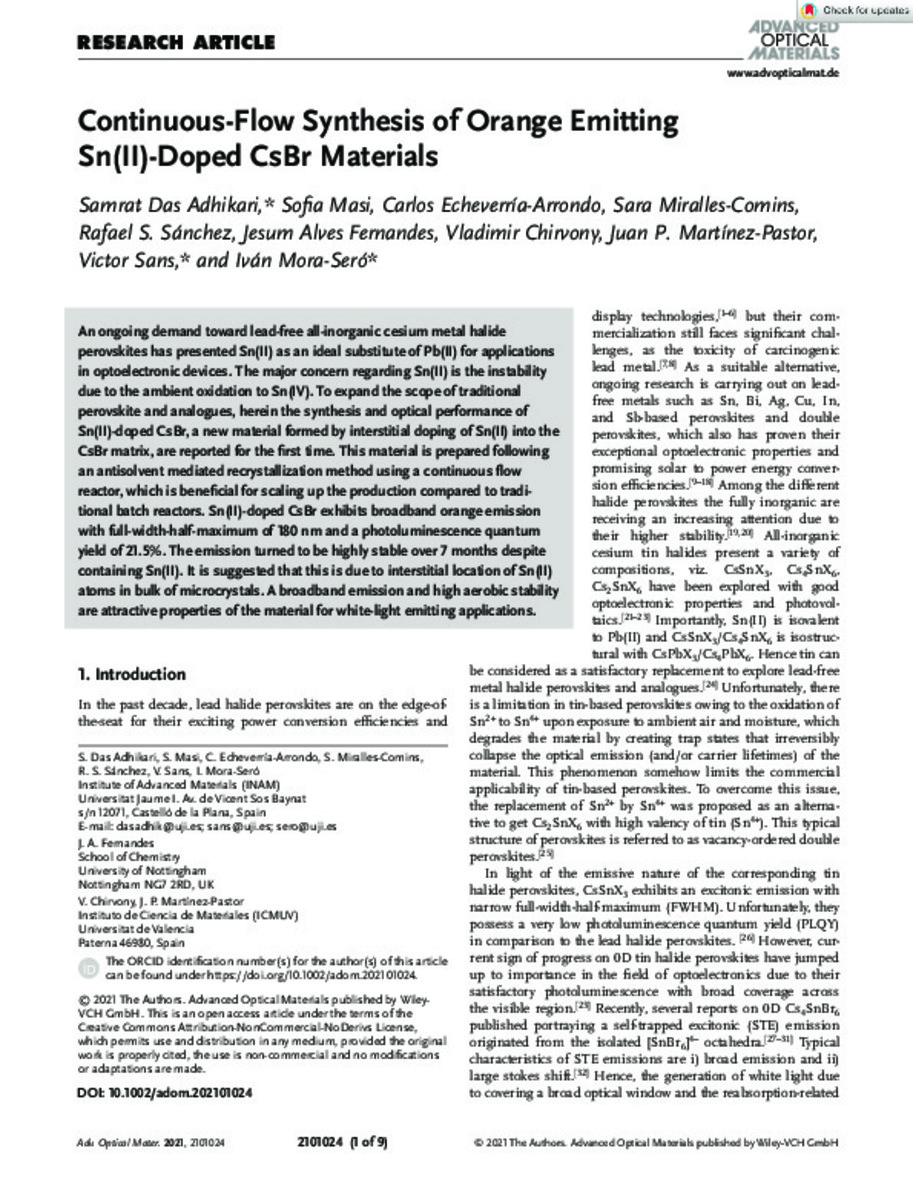Mostrar el registro sencillo del ítem
Continuous-Flow Synthesis of Orange Emitting Sn(II)-Doped CsBr Materials
| dc.contributor.author | Das Adhikari, Samrat | |
| dc.contributor.author | Masi, Sofia | |
| dc.contributor.author | Echeverría-Arrondo, Carlos | |
| dc.contributor.author | Miralles-Comins, Sara | |
| dc.contributor.author | S. Sánchez, Rafael | |
| dc.contributor.author | Alves Fernandes, Jesum | |
| dc.contributor.author | Chirvony, Vladimir | |
| dc.contributor.author | Martínez-Pastor, Juan P. | |
| dc.contributor.author | Sans, Victor | |
| dc.contributor.author | Mora-Sero, Ivan | |
| dc.date.accessioned | 2021-09-13T07:39:17Z | |
| dc.date.available | 2021-09-13T07:39:17Z | |
| dc.date.issued | 2021-09-05 | |
| dc.identifier.uri | http://hdl.handle.net/10234/194676 | |
| dc.description.abstract | An ongoing demand toward lead-free all-inorganic cesium metal halide perovskites has presented Sn(II) as an ideal substitute of Pb(II) for applications in optoelectronic devices. The major concern regarding Sn(II) is the instability due to the ambient oxidation to Sn(IV). To expand the scope of traditional perovskite and analogues, herein the synthesis and optical performance of Sn(II)-doped CsBr, a new material formed by interstitial doping of Sn(II) into the CsBr matrix, are reported for the first time. This material is prepared following an antisolvent mediated recrystallization method using a continuous flow reactor, which is beneficial for scaling up the production compared to traditional batch reactors. Sn(II)-doped CsBr exhibits broadband orange emission with full-width-half-maximum of 180 nm and a photoluminescence quantum yield of 21.5%. The emission turned to be highly stable over 7 months despite containing Sn(II). It is suggested that this is due to interstitial location of Sn(II) atoms in bulk of microcrystals. A broadband emission and high aerobic stability are attractive properties of the material for white-light emitting applications. | ca_CA |
| dc.description.sponsorShip | Funding for open access charge: CRUE-Universitat Jaume I | |
| dc.format.extent | 9 p. | ca_CA |
| dc.format.mimetype | application/pdf | ca_CA |
| dc.language.iso | eng | ca_CA |
| dc.publisher | Wiley | ca_CA |
| dc.relation.isPartOf | Adv. Optical Mater. 2021 | ca_CA |
| dc.rights | © 2021 The Authors. Advanced Optical Materials published by Wiley-VCH GmbH | ca_CA |
| dc.rights.uri | http://creativecommons.org/licenses/by-nc-nd/4.0/ | ca_CA |
| dc.subject | continuous flow reactor synthesis | ca_CA |
| dc.subject | CsBr | ca_CA |
| dc.subject | interstitial doping | ca_CA |
| dc.subject | long-term ambient stability | ca_CA |
| dc.subject | photoluminescence quantum yield | ca_CA |
| dc.subject | self-trapped excitonic emission | ca_CA |
| dc.title | Continuous-Flow Synthesis of Orange Emitting Sn(II)-Doped CsBr Materials | ca_CA |
| dc.type | info:eu-repo/semantics/article | ca_CA |
| dc.identifier.doi | https://doi.org/10.1002/adom.202101024 | |
| dc.rights.accessRights | info:eu-repo/semantics/openAccess | ca_CA |
| dc.type.version | info:eu-repo/semantics/publishedVersion | ca_CA |
| project.funder.name | European Research Council (ERC) | ca_CA |
| project.funder.name | European Commission | ca_CA |
| project.funder.name | University of Nottingham | ca_CA |
| oaire.awardNumber | 724424-No-LIMIT | ca_CA |
| oaire.awardNumber | 862656—DROP-IT | ca_CA |
Ficheros en el ítem
Este ítem aparece en la(s) siguiente(s) colección(ones)
-
INAM_Articles [523]








